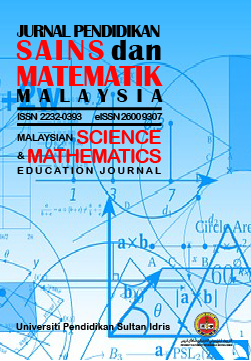Needs Analysis: Development of Year Five Science Mobile Applications for Rural National Schools in Malaysia
Analisis Keperluan: Pembangunan Aplikasi Mudah Alih Sains Tahun Lima Sekolah Kebangsaan Luar Bandar di Malaysia
DOI:
https://doi.org/10.37134/jpsmm.vol12.1.1.2022Keywords:
Need Analysis, mobile application, mobile learning, science, year fiveAbstract
The world's technological advancements are presently accelerating. This growth is centered not only in specialised areas but also in the education sector. According to previous research, Malaysian teachers do not vary their teaching strategies in the classroom. Furthermore, because teachers only utilise one method in learning and facilitation sessions, students' interests and motivation are dwindling. The Ministry of Education Malaysia's (MOE) ambition to make Malaysia a developed country in the field of Science and Technology may be hampered if this situation continues. The goal of this study was to determine the design requirements for a Science android application for national school kids in year five. In this study, the Unified Theory of Acceptance and Use of Technology (UTAUT) was employed as a base model. A survey of 188 fifth-year students from rural national schools was done to see if there was a need for a Science mobile android application in these schools. The data from the descriptive statistical analysis were examined with SPSS software version 23. Mean values, percentages, and standard deviations were used to analyse the data. According to the findings of the study, the majority of students (76.1 percent, n = 188) own at least one mobile device. The findings of this study show that rural national school fifth-year students have access to technology needs for Mobile Learning (M-Learning). The findings indicate that a Science mobile android application for M-Learning use by fifth-year students in Malaysian rural national schools is required.
Downloads
References
Abachi, H. R., & Muhammad, G. (2014). The impact of m-learning technology on students and educators. Computers in Human Behavior, 30, 491–496. https://doi.org/10.1016/j.chb.2013.06.018.
Alijah Ujang. (2016). Pembangunan Modul Pembelajaran Webquest Pendidikan Kesihatan Untuk Guru Pelatih Murid Bermasalah Pembelajaran. Tesis Doktor Falsafah. Fakulti Pendidikan, Universiti Malaya.
Aminuddin Hassan, Fadzilah Abd Rahman & Kuan Yew , S. (2015). Meneroka Pemikiran Logik Melalui Penggunaan Aplikasi Mudah Alih. International Journal of Education and Training (InjET). 1(2), 1-7.
Chachil, K., Engkamat, A., Sarkawi, A., & Shuib, A. R. A. (2015). Interactive multimedia-based Mobile Application for Learning Iban Language (I-MMAPS for Learning Iban Language). Procedia - Social and Behavioral Sciences. https://doi.org/10.1016/j.sbspro.2014.12.673.
Ewais, A., & Troyer, O. De. (2019). A Usability and Acceptance Evaluation of the Use of Augmented Reality for Learning Atoms and Molecules Reaction by Primary School Female Students in Palestine. Journal of Educational Computing, 57(7), 1–27. https://doi.org/10.1177/0735633119855609.
Falloon, G. (2017). Mobile Devices and Apps as Scaffolds to Science Learning in the Primary Classroom. Journal of Science Education and Technology, 26(December 2017), 613–628. https://doi.org/10.1007/s10956-017-9702-4.
Fazzlijan Mohamed Adnan Khan. (2015). Penilaian Koswer Multimedia Interaktif Dengan Pendekatan Koperatif Masteri Dalam Meningkatkan Pencapaian Respirasi Sel. Jurnal Pemikir Pendidikan, 81–94.
Hussain, H., & Shiratuddin, N. (2017). Multimedia Dan Antara Muka Tablet Dalam Menilai Penceritaan Digital (Reliability And Correlation Of Multimedia Element And Tablet Interface In Digital). Jurnal Ilmiah Komputer Dan Informatika (Komputa), 31, 27–45.
Iksan, Z. H., & Saufian, S. M. (2012). Mobile Learning: Innovation in Teaching and Learning Using Telegram. International Journal of Pedagogy and Teacher Education (IJPTE), 11(1), 19–26.
Kementerian Pendidikan Malaysia (2013). Pelan Pembangunan Pendidikan Malaysia 2013-2025. Putrajaya: Bahagian Pendidikan Guru.
M. Yanyan Herdiansyah & Irawan Afrianto. (2013). Pembangunan Aplikasi Bantu Dalam Menghafal Al-Quran Berbasis Mobile. Jurnal Ilmiah Komputer Dan Informatika (Komputa), 2(2).
Mingsiritham, J. K. & K. (2016). Engaging Virtual Learning Environment System to Enhance Communication and Collaboration Skills among ASEAN Higher Education Learners. International Journal of Emerging Technologies in Learning, 11(4), 103–113. Retrieved from http://10.0.15.151/ijet.v11i04.5503%5Cnhttp://search.ebscohost.com/login.aspx?direct=true&db=eue&AN=114317861&site=ehost-live.
Mohamad Zain, S. (2021). Criticism of KBAT and its successor’s recommendations. Jurnal Pendidikan Sains Dan Matematik Malaysia, 11(1), 20-29. https://doi.org/10.37134/jpsmm.vol11.1.2.2021.
Muhammad Raflee, S. S., & Halim, L. (2021). The Effectiveness of Critical Thinking in Improving Skills in KBAT Problem Solving. Jurnal Pendidikan Sains dan Matematik Malaysia, 11(1), 60-76. https://doi.org/10.37134/jpsmm.vol11.1.6.2021.
Norlidah Alias. (2013). Design and Development Research: Emergent Trends in Educational Research (pp. 1–16).
Nurahimah MohdYusof & Muhammad Nidzam Yaakob. (2016). Analisis Fuzzy Delphi Terhadap Peluang Pelaksanaan m-Pembelajaran Dalam Kalangan Pensyarah Di Institut Pendidikan Guru Malaysia. Jurnal Penyelidikan Dedikasi, Jilid 10, 98–117.
O'Bannon, B.W., & Thomas, K. (2015). Mobile phones in the classroom: Preservice teachers answer the call. Journal of Computers and Education, 85(July 2015), 110-122. https://doi.org/10.1016/j.compedu.2015.02.010.
Othman, A., Ibrahim, D. A., Abdullah, N. A., & Umanan, F. (2021). Development of Teaching and Learning Model using TPACK Framework and Effectiveness of e-Learning for Matriculation Chemistry subject. Jurnal Pendidikan Sains Dan Matematik Malaysia, 11(1), 1-19. https://doi.org/10.37134/jpsmm.vol11.1.1.2021.
Oz, H. (2014). Prospective English Teachers ’ Ownership And Usage Of Mobile Devices As M-Learning Tools. Procedia - Social and Behavioral Sciences. https://doi.org/11.1017/j.sbspro.2014.17.536.
Pallant, J. (2007). SPSS survival manual—A step-by-step guide to data analysis using SPSS for windows (3rd ed.). Maidenhead: Open University Press.
Rafiee Jamian & Hafsah Taha. (2020). Analisis Keperluan Kebolehgunaan Aplikasi Mudah Alih Terhadap Sikap, Minat dan Pengetahuan Asas Matematik Tahun 4. Jurnal Pendidikan Sains dan Matematik Malaysia, 10(1), 9-15. https://doi.org/10.37134/jpsmm.vol10.1.2.2020.
Ramlan Mustapha. (2017). Reka Bentuk Model Integriti Akademik Berasaskan Penghayatan Rohani. Tesis Doktor Falsafah. Fakulti Pendidikan, Universiti Malaya.
Saleh, M. P. (2016). Model pengajaran M-Pembelajaran berasaskan kaedah inkuiri mata pelajaran sejarah peringkat menengah. Tesis Doktor Falsafah, Fakulti Pendidikan, Universiti Malaya.
Sharples, M., Taylor, J., & Vavoula, G. (2007). A Theory of Learning for the Mobile Age. In R. Andrews, & C. Haythornthwaite (Eds.), The SAGE Handbook of E-Learning Research (pp. 221-247). Thousand Oaks, California: SAGE.
Shi, Z., Luo, G., & He, L. (2017). Mobile-assisted language learning using WeChat instant messaging. International Journal of Emerging Technologies in Learning, 12(2), 16–26. https://doi.org/10.3991/ijet.v12i02.6681.
Siti Norsyiqah Azmi &, & Khairunniza Abdul Hamid. (2018). Penggunaan Nota Digital Meningkatkan Pencapaian Murid Dalam Mata Pelajaran Sejarah Tingkatan Satu (pp. 413–434).
Venkatesh V., Morris M.G., Davis F.D. & Davis G.B. (2003). User acceptance of information technology: Toward a unified view. MIS Quarterly 27: 425-478.





